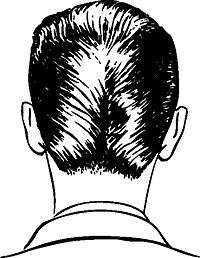Duck's ass

The duck's ass is a haircut style that was popular during the 1950s. It is also called the duck's tail, the ducktail, the duck's arse (UK), or simply D.A., and is also described as slicked back hair.
History
Joe Cirello, a barber from Philadelphia, claimed to have invented the Duck's Ass in 1940.[1] A similar hairstyle, sometimes called the Argentine ducktail, consisting of greased hair piled high on top and swept back at the sides to form a ridge or seam at the back, was simultaneously fashionable among the Mexican-American Pachucos of Los Angeles. The Duck's tail became an emblematic coiffure of disaffected young males across the English-speaking world during the 1950s. In Britain, it formed part of the visual identity of Teddy Boys and Rockers, along with the Quiff and the Elephant's Trunk.
Combing technique
The style required that the hair be combed back around the sides of the head. The teeth edge of a comb was then used to define a central parting running from the crown to the nape at the back of the head, resembling, to many, the rear end of a duck. The hair on the top front of the head was either deliberately disarrayed so that untidy strands hung down over the forehead, or combed up and then curled down into an 'Elephants trunk' which would hang down as far as the top of the nose. The sides were styled to resemble the folded wings of the duck.
A variant of the style, the Detroit, consisted of the long back and sides combined with a flattop. In California, the top hair was allowed to grow longer and combed into a wavelike pompadour shape known as a "breaker".
The ducktail hair style contributed to the term greasers: to accomplish this look, lots of pomade (hair grease) was required to hold the hair in place. This was still the era of hair creams, so it only required an increase in the amount to make hair remain in the desired style. Brands of grease used include Black & White, Sweet Georgia Brown, Royal Crown, and Murrays. On the West Coast of the US, pomades such as Dixie Peach or Brylcreem, and tonics such as Wildroot Cream-oil were popular.
To ensure that the hair was just so, the wearer often touched up the D.A. many times during the day by running his greased comb through it. This led to a stylized means of handling the comb by drawing it out of the back pocket of a pair of jeans using the extended index and middle finger, and, holding it thus, running the comb through the two side "wings" of the style to adjust their shape.
Significance
The D.A. quickly became a stereotypical feature of rebels and nonconformists, and gained popularity especially after the rise of rock 'n roll legend Elvis Presley, who sported the same look. Although the ducktail was adopted by Hollywood to represent the wild youth of the Fifties, only a minority of males actually sported a D.A., even amongst the British Rockers and Teddy Boys of the same era. The style became popular in India after film star Shammi Kapoor started sporting it.
In popular culture
"Ducktail", the 1956 rockabilly song by Joe Clay, insists on the care one takes to maintain the hairdo. The lyrics warning the listener, "Don't mess with my ducktails", echo Carl Perkins's "(Don't Step on My) Blue Suede Shoes", which appeared the same year. Several characters in various comics, manga, and anime sport DAs. For example, It is common to many characters in the series Jojo's Bizarre Adventure, most notably Josuke Higashikata, who is identified by the hairstyle.
The Happy Days character Fonzie also has one, as do "Lenny" (Michael McKean) and "Squiggy" (David Lander) on the TV series Laverne and Shirley. Al Davis also has worn his hair in a DA, as did Ken Wahl in his role as Vinnie Terranova in the dressier sequences of the cult TV drama, Wiseguy.
In the Discworld book Soul Music, the Dean of Unseen University adopts this style (possibly a reference to James Dean). This earns him the disapproval of Mustrum Ridcully, and his choice of bacon fat as a substitute for hair cream also proves to be somewhat suboptimal.
References
- ↑ Wallace, Andy (15 February 1994). "'Duck Cut' inventor Cirello, barber to stars dies at 79". Ocala Star-Banner. Retrieved 24 February 2014.